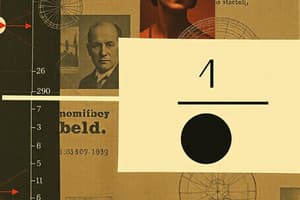Podcast
Questions and Answers
Calculate: $\frac{2}{5} + \frac{1}{3}$
Calculate: $\frac{2}{5} + \frac{1}{3}$
$\frac{11}{15}$
Evaluate: $\frac{7}{8} - \frac{1}{4}$
Evaluate: $\frac{7}{8} - \frac{1}{4}$
$\frac{5}{8}$
Simplify: $2\frac{1}{2} + 1\frac{1}{3}$
Simplify: $2\frac{1}{2} + 1\frac{1}{3}$
$3\frac{5}{6}$
What is: $3\frac{3}{4} - 1\frac{1}{2}$?
What is: $3\frac{3}{4} - 1\frac{1}{2}$?
Compute: $\frac{5}{6} + \frac{2}{3} - \frac{1}{2}$
Compute: $\frac{5}{6} + \frac{2}{3} - \frac{1}{2}$
Determine: $4\frac{1}{5} - 2\frac{3}{10}$
Determine: $4\frac{1}{5} - 2\frac{3}{10}$
Calculate: $1\frac{1}{4} + 2\frac{2}{5} - \frac{1}{10}$
Calculate: $1\frac{1}{4} + 2\frac{2}{5} - \frac{1}{10}$
Evaluate: $\frac{7}{12} - \frac{1}{3} + \frac{5}{6}$
Evaluate: $\frac{7}{12} - \frac{1}{3} + \frac{5}{6}$
What is: $5\frac{1}{3} - (2\frac{1}{4} + \frac{1}{6})$
What is: $5\frac{1}{3} - (2\frac{1}{4} + \frac{1}{6})$
Simplify: $3\frac{5}{8} + 1\frac{1}{4} - \frac{1}{2}$
Simplify: $3\frac{5}{8} + 1\frac{1}{4} - \frac{1}{2}$
Flashcards
Like Fractions
Like Fractions
Fractions with the same denominator.
Unlike Fractions
Unlike Fractions
Fractions with different denominators that need adjustment for operations.
Numerator
Numerator
The number above the fraction bar, indicating the number of parts of the whole.
Denominator
Denominator
Signup and view all the flashcards
Mixed Number
Mixed Number
Signup and view all the flashcards
Equivalent Fractions
Equivalent Fractions
Signup and view all the flashcards
Least Common Denominator (LCD)
Least Common Denominator (LCD)
Signup and view all the flashcards
Operations with Like Fractions
Operations with Like Fractions
Signup and view all the flashcards
Operations with Unlike Fractions
Operations with Unlike Fractions
Signup and view all the flashcards
Adding Mixed Numbers
Adding Mixed Numbers
Signup and view all the flashcards
Study Notes
- Adding and subtracting fractions is a fundamental arithmetic skill involving rational numbers
- Mastery requires understanding of numerators, denominators, equivalent fractions, and common denominators
Adding Fractions with Like Denominators
- When fractions have the same denominator, addition involves adding the numerators and keeping the denominator the same
- Example: 1/5 + 2/5 = (1+2)/5 = 3/5
- The denominator represents the total number of equal parts of a whole, while the numerator represents the number of those parts you have
- The result should be simplified if possible, by reducing the fraction to its lowest terms
Subtracting Fractions with Like Denominators
- Subtraction with like denominators follows a similar process
- Subtract the numerators and keep the denominator the same
- Example: 4/7 - 1/7 = (4-1)/7 = 3/7
- Ensure the result is simplified to its lowest terms
Adding Fractions with Unlike Denominators
- When fractions have different denominators, a common denominator must be found before adding
- The least common denominator (LCD) is the smallest multiple that both denominators share
- One method to find the LCD is listing the multiples of each denominator until a common multiple is found
- Example: For 1/4 and 2/6, multiples of 4 are 4, 8, 12, 16..., and multiples of 6 are 6, 12, 18...
- Thus, the LCD is 12
- Once the LCD is found, each fraction must be converted into an equivalent fraction with the LCD as the new denominator
- Multiply both the numerator and denominator of each fraction by the factor that makes the original denominator equal to the LCD
- Once both fractions have the same denominator, add the numerators and keep the common denominator
- Simplify the resulting fraction if necessary
Subtracting Fractions with Unlike Denominators
- Subtraction with unlike denominators is similar to addition, but involves subtracting the numerators after finding the LCD and converting the fractions
- Example: To subtract 1/3 from 1/2, find the LCD of 3 and 2, which is 6
- Convert 1/2 to 3/6 (multiply numerator and denominator by 3)
- Convert 1/3 to 2/6 (multiply numerator and denominator by 2)
- Subtract the numerators: 3/6 - 2/6 = (3-2)/6 = 1/6
Adding Mixed Numbers
- A mixed number consists of a whole number and a proper fraction (where the numerator is less than the denominator)
- To add mixed numbers, there are generally two methods: adding whole numbers and fractions separately, or converting mixed numbers to improper fractions
- Method 1: Add the whole numbers together and then add the fractions together
- If the sum of the fractions results in an improper fraction, convert it to a mixed number and add the whole number part to the sum of the whole numbers
- Method 2: Convert each mixed number to an improper fraction (numerator is greater than or equal to the denominator)
- To convert, multiply the whole number by the denominator and add the numerator, then place the result over the original denominator
- Then, add the improper fractions (after finding a common denominator if necessary)
- Convert the resulting improper fraction back to a mixed number if needed
Subtracting Mixed Numbers
- Subtracting mixed numbers also involves two main methods: subtracting whole numbers and fractions separately, or converting to improper fractions
- Method 1: Subtract the whole numbers and fractions separately
- Borrow from the whole number if the fraction being subtracted is larger than the fraction being subtracted from
- Method 2: Convert each mixed number to an improper fraction
- Subtract the improper fractions (after finding a common denominator if necessary)
- Convert the resulting improper fraction back to a mixed number if needed
Simplifying Fractions and Mixed Numbers
- Simplification involves reducing a fraction to its lowest terms
- Divide both the numerator and the denominator by their greatest common factor (GCF)
- The GCF is the largest number that divides both the numerator and denominator without leaving a remainder
- Keep simplifying until numerator and denominator have no common factors other than 1
- For Mixed Numbers, ensure the fractional part is simplified
Real-World Applications
- These operations with fractions are essential in various real-world scenarios
- Cooking: Recipes often involve fractional quantities of ingredients
- Measurement: Construction, woodworking, and sewing often require precise measurements using fractions
- Finance: Calculating portions of investments, interest rates, or discounts
- Time Management: Scheduling and planning activities often involve breaking down time into fractions of hours or minutes
Studying That Suits You
Use AI to generate personalized quizzes and flashcards to suit your learning preferences.




